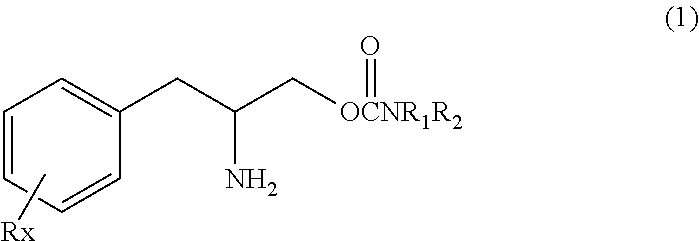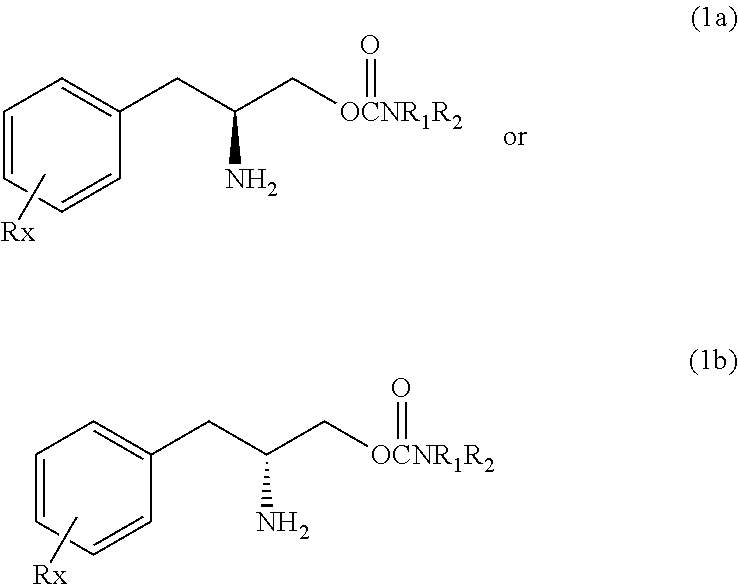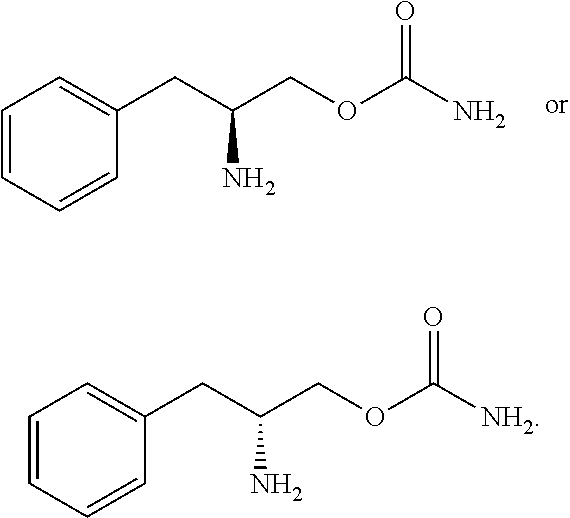Methods for treating fibromyalgia syndrome
a technology for fibromyalgia and fibromyalgia, applied in the direction of biocide, muscular disorder, drug composition, etc., can solve the problems of fatigue, mind and body fatigue, and insufficient restorative sleep alone to reduce fatigue, so as to achieve novel and unique pharmacological properties
- Summary
- Abstract
- Description
- Claims
- Application Information
AI Technical Summary
Benefits of technology
Problems solved by technology
Method used
Image
Examples
example 1
[0115]The test compound (0-carbamoyl-(D)-phenylalaninol) administered at 30 mg / kg intraperitoneally (IP) significantly increased paw withdrawal latency to a thermal stimulus in rats with sciatic nerve ligation. These data suggest that the test compound shows anti-thermal hyperalgesic properties.
[0116](Methods)
[0117]Young adult male Sprague-Dawley rats (CD(SD)IGS, 150-200 g) were initially anesthetized with isoflurane in O2 by a mask and the surgical procedure was performed according to the method described by Bennett and Xie (1988). Briefly, the right sciatic nerves were loosely tied using ligatures. All experiments were conducted in accordance with the guidelines of the International Association for the Study of Pain. The behavioral tests were conducted at least 14 days postoperatively.
[0118]The test compound was dissolved in saline and administered intraperitoneally at 30 mg / kg to animals in a volume of 3 mL / kg body weight.
[0119]To test for thermal hyperalgesia, the thermal respon...
example 2
[0123]The effects of the test compound (50-150 mg / kg, PO) on various sleep parameters were evaluated in 8 hypocretin cell ablated narcoleptic mice (prepororexin / ataxin-3 transgenic) and their littermate wild-type mice, and the effects were compared with those of modafinil, a reference wake-promoting compound. The test compound showed significantly increased bouts of wakefulness in both wild-type and narcoleptic mice and was able to normalize sleep patterns of narcoleptic mice.
[0124](Methods)
[0125]The polygraph signal (EEG and EMG) was captured with SleepSign (Kissei Comtech), and the sleep stage was visually scored with 10 sec epoch for wakefulness, non-REM sleep and REM sleep. Scoring criteria are: Wakefulness is characterized by desynchronized low-amplitude, mixed frequency (>4 Hz) EEG and high EMG activity. Rhythmic alpha (8-9 Hz) wave (with high EMG activities) may also appear. Non-REM is characterized by synchronized, high-amplitude, low-frequency (0.25-4 Hz) with reduced EMG a...
example 3
[0136]The test compound was tested for the effects on the forced swimming test, an animal model of depression, in both mice and rats. After single doses of the test compound the mean duration of immobility was reduced with an ED50 of 16.6 mg / kg PO in mice and 18.5 mg / kg PO in rats. The test compound was even more potent after multiple dosing in mice with an ED50 of 5.5 mg / kg PO. These data suggest that the test compound shows antidepressant properties.
[0137](Methods)
[0138]Male CD-1 mice (16-24 g) and male Wistar rats (90-125 g) were utilized in these experiments. The test compound (10, 15 and 30 mg / kg) was dissolved in physiological saline (0.9%) and administered orally PO in a volume of 1 mL / 100 g body weight.
[0139]Mice and rats were placed in glass cylinders (1000 ml beakers; height 14 cm, diameter 11.5 cm) and (4000 ml beakers; height 24.5 cm, diameter 18.0 cm) respectively, containing water (25 degrees Celsius) up to a height of 9.0 cm for mice and 19.0 for rats. Each mouse or r...
PUM
| Property | Measurement | Unit |
|---|---|---|
| weight | aaaaa | aaaaa |
| frequency | aaaaa | aaaaa |
| frequency | aaaaa | aaaaa |
Abstract
Description
Claims
Application Information
 Login to View More
Login to View More - R&D
- Intellectual Property
- Life Sciences
- Materials
- Tech Scout
- Unparalleled Data Quality
- Higher Quality Content
- 60% Fewer Hallucinations
Browse by: Latest US Patents, China's latest patents, Technical Efficacy Thesaurus, Application Domain, Technology Topic, Popular Technical Reports.
© 2025 PatSnap. All rights reserved.Legal|Privacy policy|Modern Slavery Act Transparency Statement|Sitemap|About US| Contact US: help@patsnap.com



